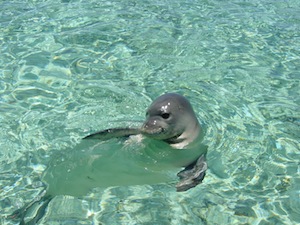Recent Publications
![]() Alexandros A. Karamanlidis, P. Jeff Curtis, Amy C. Hirons, Marianna Psaradellis, Panagiotis Dendrinos and John B. Hopkins III. 2014. Stable isotopes confirm a coastal diet for critically endangered Mediterranean monk seals. Isotopes in Environmental and Health Studies, http://dx.doi.org/10.1080/10256016.2014.931845.
Alexandros A. Karamanlidis, P. Jeff Curtis, Amy C. Hirons, Marianna Psaradellis, Panagiotis Dendrinos and John B. Hopkins III. 2014. Stable isotopes confirm a coastal diet for critically endangered Mediterranean monk seals. Isotopes in Environmental and Health Studies, http://dx.doi.org/10.1080/10256016.2014.931845.
Abstract
Understanding the ecology and behaviour of endangered species is essential for developing effective management and conservation strategies. We used stable isotope analysis to investigate the foraging behaviour of critically endangered Mediterranean monk seals (Monachus monachus) in Greece. We measured carbon and nitrogen isotope ratios (expressed as δ13C and δ15N values, respectively) derived from the hair of deceased adult and juvenile seals and the muscle of their known prey to quantify their diets. We tested the hypothesis that monk seals primarily foraged for prey that occupy coastal habitats in Greece. We compared isotope values from seal hair to their coastal and pelagic prey (after correcting all prey for isotopic discrimination) and used these isotopic data and a stable isotope mixing model to estimate the proportion of coastal and pelagic resources consumed by seals. As predicted, we found that seals had similar δ13C values as many coastal prey species and higher δ13C values than pelagic species; these results, in conjunction with mean dietary estimates (coastal=61 % vs. pelagic=39 %), suggest that seals have a diverse diet comprising prey from multiple trophic levels that primarily occupy the coast. Marine resource managers should consider using the results from this study to inform the future management of coastal habitats in Greece to protect Mediterranean monk seals.

 The Final PEIS for Hawaiian Monk Seal Recovery Actions was made available for public review from April 11 to May 12, 2014. The Preferred Alternative identified in the Final PEIS is Alternative 3, Limited Translocation. The Preferred Alternative does not include any translocation option that involves moving seals born in the Northwestern Hawaiian Islands and releasing them in the main Hawaiian Islands. The Final PEIS is available at:
The Final PEIS for Hawaiian Monk Seal Recovery Actions was made available for public review from April 11 to May 12, 2014. The Preferred Alternative identified in the Final PEIS is Alternative 3, Limited Translocation. The Preferred Alternative does not include any translocation option that involves moving seals born in the Northwestern Hawaiian Islands and releasing them in the main Hawaiian Islands. The Final PEIS is available at: